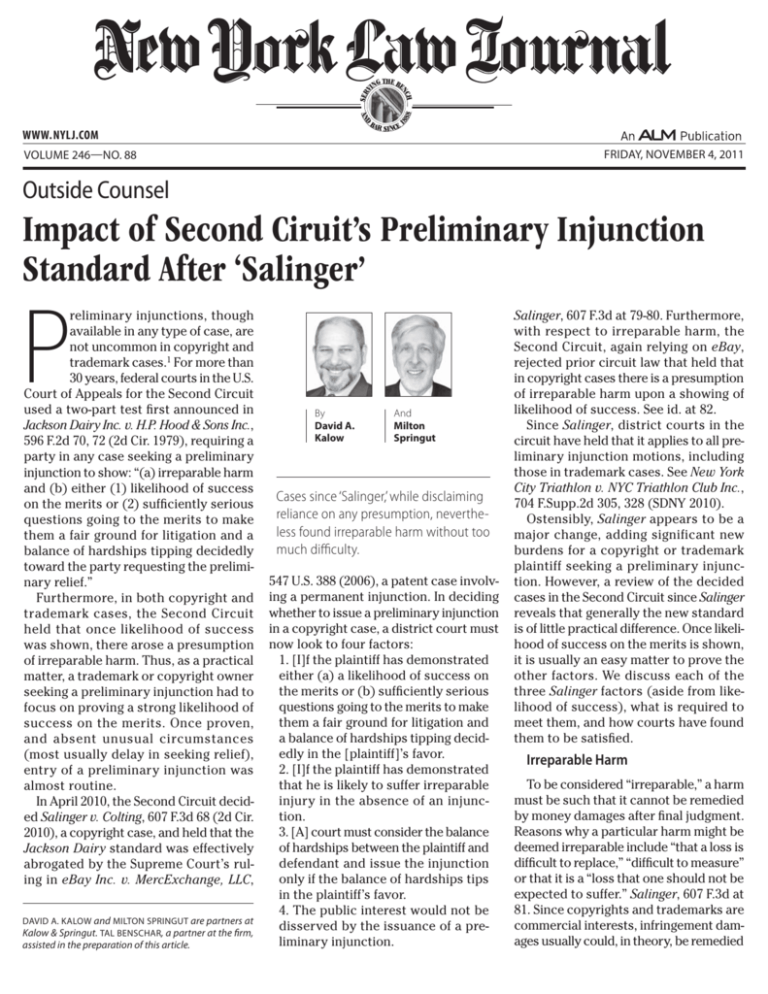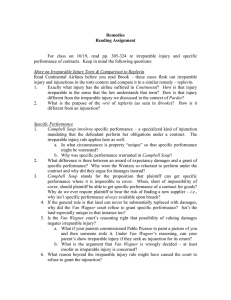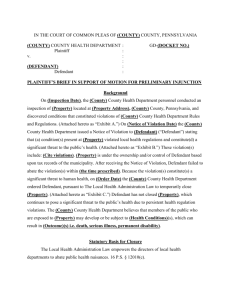
SER
V
H
NC
AND
88
8
THE BE
ING
1
BA
R SINCE
WWW. NYLJ.COM
FRIDAY, NOVEMBER 4, 2011
VOLUME 246NO. 88
Outside Counsel
Impact of Second Ciruit’s Preliminary Injunction
Standard After ‘Salinger’
P
reliminary injunctions, though
available in any type of case, are
not uncommon in copyright and
trademark cases.1 For more than
30 years, federal courts in the U.S.
Court of Appeals for the Second Circuit
used a two-part test first announced in
Jackson Dairy Inc. v. H.P. Hood & Sons Inc.,
596 F.2d 70, 72 (2d Cir. 1979), requiring a
party in any case seeking a preliminary
injunction to show: “(a) irreparable harm
and (b) either (1) likelihood of success
on the merits or (2) sufficiently serious
questions going to the merits to make
them a fair ground for litigation and a
balance of hardships tipping decidedly
toward the party requesting the preliminary relief.”
Furthermore, in both copyright and
trademark cases, the Second Circuit
held that once likelihood of success
was shown, there arose a presumption
of irreparable harm. Thus, as a practical
matter, a trademark or copyright owner
seeking a preliminary injunction had to
focus on proving a strong likelihood of
success on the merits. Once proven,
and absent unusual circumstances
(most usually delay in seeking relief),
entry of a preliminary injunction was
almost routine.
In April 2010, the Second Circuit decided Salinger v. Colting, 607 F.3d 68 (2d Cir.
2010), a copyright case, and held that the
Jackson Dairy standard was effectively
abrogated by the Supreme Court’s ruling in eBay Inc. v. MercExchange, LLC,
DAVID A. KALOW and MILTON SPRINGUT are partners at
Kalow & Springut. TAL BENSCHAR, a partner at the firm,
assisted in the preparation of this article.
By
David A.
Kalow
And
Milton
Springut
Cases since ‘Salinger,’ while disclaiming
reliance on any presumption, nevertheless found irreparable harm without too
much difficulty.
547 U.S. 388 (2006), a patent case involving a permanent injunction. In deciding
whether to issue a preliminary injunction
in a copyright case, a district court must
now look to four factors:
1. [I]f the plaintiff has demonstrated
either (a) a likelihood of success on
the merits or (b) sufficiently serious
questions going to the merits to make
them a fair ground for litigation and
a balance of hardships tipping decidedly in the [plaintiff]’s favor.
2. [I]f the plaintiff has demonstrated
that he is likely to suffer irreparable
injury in the absence of an injunction.
3. [A] court must consider the balance
of hardships between the plaintiff and
defendant and issue the injunction
only if the balance of hardships tips
in the plaintiff’s favor.
4. The public interest would not be
disserved by the issuance of a preliminary injunction.
Salinger, 607 F.3d at 79-80. Furthermore,
with respect to irreparable harm, the
Second Circuit, again relying on eBay,
rejected prior circuit law that held that
in copyright cases there is a presumption
of irreparable harm upon a showing of
likelihood of success. See id. at 82.
Since Salinger, district courts in the
circuit have held that it applies to all preliminary injunction motions, including
those in trademark cases. See New York
City Triathlon v. NYC Triathlon Club Inc.,
704 F.Supp.2d 305, 328 (SDNY 2010).
Ostensibly, Salinger appears to be a
major change, adding significant new
burdens for a copyright or trademark
plaintiff seeking a preliminary injunction. However, a review of the decided
cases in the Second Circuit since Salinger
reveals that generally the new standard
is of little practical difference. Once likelihood of success on the merits is shown,
it is usually an easy matter to prove the
other factors. We discuss each of the
three Salinger factors (aside from likelihood of success), what is required to
meet them, and how courts have found
them to be satisfied.
Irreparable Harm
To be considered “irreparable,” a harm
must be such that it cannot be remedied
by money damages after final judgment.
Reasons why a particular harm might be
deemed irreparable include “that a loss is
difficult to replace,” “difficult to measure”
or that it is a “loss that one should not be
expected to suffer.” Salinger, 607 F.3d at
81. Since copyrights and trademarks are
commercial interests, infringement damages usually could, in theory, be remedied
FRIDAY, NOVEMBER 4, 2011
by money. Nevertheless, the harm suffered by a copyright or trademark owner
through infringement will almost always
be deemed irreparable because it is usually difficult to measure or quantify or fully
account for.
Copyright Cases. Salinger itself suggests three possible reasons why the
harm in copyright cases might be irreparable. First, where the copyright is closely
associated with a particular artist or
source, the harm may be irreparable
because of “possible market confusion.”
Second, where the infringing product
competes with the copyright owner’s
(or licensee’s) own product and causes
sales losses, such harm is usually deemed
irreparable because “to prove the loss of
sales due to infringement is notoriously
difficult.” Third, where the infringement
could result in a particular message being
misattributed to a particular author, “the
loss of First Amendment freedoms, and
hence the infringement of the right not
to speak for even minimal periods of
time, unquestionably constitutes irreparable injury.” See Salinger, 607 F.3d at 81.
Other courts have adopted other rationales. One court combined the first two
Salinger rationales in a case involving
copyrighted stuffed toys. Because the
defendant had “flood[ed] the market
with counterfeit products,” there was
a distinct danger both of lost sales and
damage to the plaintiff’s reputation,
both of which are difficult to calculate
and hence irreparable. CJ Prods. LLC v.
Concord Toys Intl. Inc., 2011 U.S.Dist.
Lexis 4983 (SDNY 2011). Another court,
adopting a similar rationale from patent
law, held that the “loss of pricing power
resulting from the sale of inexpensive
‘knock-offs’ is, by its very nature, irreparable.” Mint Inc. v. Amad, 2011 U.S. Dist.
LEXIS 49813, *10-11 (SDNY 2011).
In a case involving pirated streaming
of television programming over the Internet, the court found the harm irreparable
because the streaming threatened to
divert viewers from the plaintiff’s own
authorized broadcasts, and thus would
interfere with its own licensing and advertising revenues program; such loss was
the equivalent of loss of sales which are
often hard to prove. WPIX Inc. v. ivi Inc.,
2011 U.S. Dist. LEXIS 17654, *65-72 (SDNY
2011). That court also noted, but did not
address, the plaintiff’s argument that by
streaming the content over the Internet,
the defendant had deprived it of valuable anti-copying measures that would
prevent further infringements. See id.
Since copyrights and trademarks are
commercial interests, infringement
damages usually could, in theory, be
remedied by money. Nevertheless, the
harm suffered by a copyright or trademark owner through infringement will
almost always be deemed irreparable
because it is usually difficult to measure
or quantify or fully account for.
Trademark Cases. Trademark cases
generally present an even easier case
than copyright cases for showing irreparable harm. By definition, a trademark is
nothing more than a symbol of the goodwill and reputation of a business. To show
that a defendant has infringed a trademark, it is necessary to show that there
is a “likelihood of confusion” between
the parties. Once that is shown, then
perforce the trademark owner’s business
reputation is in jeopardy. Such harm is
almost by definition “irreparable.” This
is the very reason that courts traditionally adopted a presumption of irreparable
harm in trademark cases. See Genesee
Brewing Co. v. Stroh Brewing Co., 124 F.3d
137, 142 (2d Cir. 1997). See also Omega
Importing Corp. v. Petri-Kine Camera Co.,
451 F.2d 1190, 1195 (2d Cir. 1971) (discussing irreparable harms in a typical
infringement case).
Not surprisingly, cases since Salinger,
while disclaiming reliance on any presumption, nevertheless found irreparable harm without too much difficulty. In
one case, a court held the harm irreparable because (1) the plaintiff had built up
a substantial goodwill in its trademark,
which the defendant could jeopardize
and (2) the infringement by defendant
of the mark would cause the plaintiff
to lose control over the reputation of
its marks pending trial, and the damage
caused by such loss of control “is neither
calculable nor precisely compensable.”
New York City Triathlon, 704 F.Supp.2d
at 343. Other courts have relied upon
one or both of these rationales. See U.S.
Polo Assoc. Inc. v. PRL USA Holdings Inc.,
2011 U.S. Dist. Lexis 51707, *61-62 (SDNY
2011); The Marks Org. Inc. v. Joles, 2011
U.S. Dist. Lexis 28182, *26-29 (SDNY
2011); Pretty Girl Inc. v. Pretty Girl Fashions Inc., 2011 U.S. Dist. Lexis 25755
*17-21 (SDNY 2011).
Thus, in most trademark and copyright
cases, the harm suffered by the plaintiff
will usually fit into one or more frequently
recurring fact patterns that have long
been held to exemplify “irreparable”
harm. Generally, once likelihood of success is demonstrated, it should not be
difficult for counsel to articulate how the
facts of the case fit into one or more of
these recurring patterns.
Balance of Hardships
This factor is relatively new to Second
Circuit jurisprudence. In some reported
cases since Salinger, the court has simply noted that the defendant has only
recently entered the market, is not heavily invested in a particular product or
mark, and thus would be harmed little by
an injunction. In the trademark context,
at least, some courts also note that an
injunction not to use a particular trademark does not necessarily close down
the defendant’s business; the defendant
is always free to compete freely and fully
with the plaintiff, so long as it uses a different mark to identify itself, one that will
not confuse consumers. See The Marks
Org. Inc. v. Joles, 2011 U.S. Dist. Lexis
28182, *31-32.
Some courts go further. In balancing
the harms to the respective parties,
they completely discount the harm to
the defendant to the extent it is based on
infringement. This concept has its origin
in a famous decision by Judge Learned
Hand, My-T Fine Corp. v. Samuels, 69 F.2d
76, 78 (2d Cir. 1934) (“[A]dvantages built
upon a deliberately plagiarized make-up
do not seem to us to give the borrower
any standing to complain that his vested interests will be disturbed.”) More
recently, courts have held that any disadvantage the defendant would face by
being forced to discontinue its business
based on infringement was not legally
cognizable and would not be taken
into account in balancing the harms.
See WPIX Inc. v. ivi Inc., 2011 U.S. Dist.
Lexis 17654, *74 (SDNY 2011), Cf. Mint
Inc. v. Amad, 2011 U.S. Dist. Lexis 49813,
* 10-11. Thus, here again, the additional
requirement of showing that the “bal-
FRIDAY, NOVEMBER 4, 2011
ance of hardships” favors an injunction
in most cases is easily met.
One notable exception, however, is
where the infringing elements that the
defendant has copied are only a small
component of a whole, and the balance
consists of a substantial amount of non-infringing product or work. Such a fact pattern was presented in the famous BlackBerry patent case (NTP Inc. v. Research
in Motion, Ltd.), where the plaintiff held a
patent on technology incorporated into
the BlackBerry product, but which had
many other components as well.
More recently, a copyright case from
another circuit also presented such a
fact pattern. In Whitmill v. Warner Bros.
Ent., (No. 11-Civ.-752) (E.D.Mo. 2011),
the Eastern District of Missouri denied
a preliminary injunction on balance of
hardship grounds, even though it found
a likelihood of success on the merits.
The copyrighted work was a face tattoo
the plaintiff designed and imprinted on
Mike Tyson’s face, which was then allegedly copied onto a character’s face in
the movie “The Hangover Part II.” The
court denied the preliminary injunction
because while the appearance of the
copyrighted tattoo was likely an infringement, the tattoo itself was only a small
part of the movie as a whole. Further,
enjoining release of the movie at the last
minute would cause substantial harm not
only to the movie studio, but also to hundreds of movie theaters throughout the
country. The defendant had a substantial
and legitimate interest in the rest of the
movie that would be greatly burdened
by an injunction.
Public Interest
This factor seems to have minimal
impact on whether to grant a preliminary injunction in copyright and trademark cases. Often, courts simply recite
that it is in the public interest to enforce
these laws, see Mint Inc. v. Amad, 2011
U.S. Dist. Lexis 49813, * 11, or that there
is a public interest in avoiding consumer deception that generally accompanies trademark infringement. See
New York City Triathlon, 704 F.Supp.2d
at 344.
In Salinger, the Second Circuit noted
that the aims of copyright law align the
public’s interest with that of the plain-
tiff: “The object of copyright law is to
promote the store of knowledge available to the public. But to the extent
it accomplishes this end by providing
individuals a financial incentive to contribute to the store of knowledge, the
public’s interest may well be already
accounted for by the plaintiff’s interest.” 607 F.3d at 82.
The Salinger court did warn that an
injunction acts as a prior restraint and
thus implicates First Amendment rights
and the public’s interest in full and free
expression of ideas. But generally such
is not a significant concern in a copyright
(or trademark case):
The public’s interest in free expression, however, is significant and is
distinct from the parties’ speech
interests. [citation omitted] By protecting those who wish to enter the
marketplace of ideas from government attack, the First Amendment
protects the public’s interest in
receiving information. Every injunction issued before a final adjudication
on the merits risks enjoining speech
protected by the First Amendment.
Some uses, however, will so patently
infringe another’s copyright, without giving rise to an even colorable
fair use defense, that the likely First
Amendment value in the use is virtually nonexistent.
Salinger, 607 F.3d at 82-83.
It follows that for copyright cases
where there is a substantial fair use
defense—e.g., those involving criticism
or parody—then the “public interest”
prong of eBay may make a difference.
Generally, however, the public’s interest
is aligned with the plaintiff’s interest in
rigorous enforcement of its intellectual
property rights.
The First Amendment argument is
also weakened by another copyright
doctrine: the idea-expression dichotomy.
The Supreme Court has recognized that
the denial of copyright in ideas in the
Copyright Act is a “built in First Amendment accommodation[]” of copyright law.
Eldred v. Ashcroft, 537 U.S. 186, 219 (2003).
By definition, an injunction in a copyright
case only limits use of the copyright
holder’s expression; “every idea, theory
and fact in a copyrighted work becomes
instantly available for public exploitation
at the moment of publication.” Id. Thus,
just as a defendant in a trademark case
is free to sell a competing product with
a different trademark, so a defendant in
a copyright case is free to express the
same ideas using a different expression.
This generally is sufficient to satisfy any
First Amendment concerns.
Conclusion
The effect of the new Salinger standard
for preliminary injunctions in copyright
and trademark cases appears to be less
than what would appear at first glance.
A plaintiff seeking such relief should still
concentrate on showing a strong likelihood of success on the merits. Once
shown, in most cases the case will fit
easily into the rationales of the prior
decided cases which found all four Salinger factors.
rrrrrrrrrrrrrrrr
rrrrrrrrrrrrr
1. In contrast, they are not very common in patent cases.
The U.S. Court of Appeals for the Federal Circuit has held
that even in patent cases, it will apply the law of the regional
circuit to set the standard required for a preliminary injunction. See Mikohn Gaming Corp. v. Acres Gaming Inc., 165 F.3d
891, 894 (Fed.Cir. 1998). Thus a change in Second Circuit
preliminary-injunction law could affect patent cases brought
in the Second Circuit.
Reprinted with permission from the November 4, 2011 edition of the NEW YORK LAW
JOURNAL © 2011 ALM Media Properties, LLC. All rights reserved. Further duplication
without permission is prohibited. For information, contact 877-257-3382 or reprints@alm.
com. # 070-11-11-13








